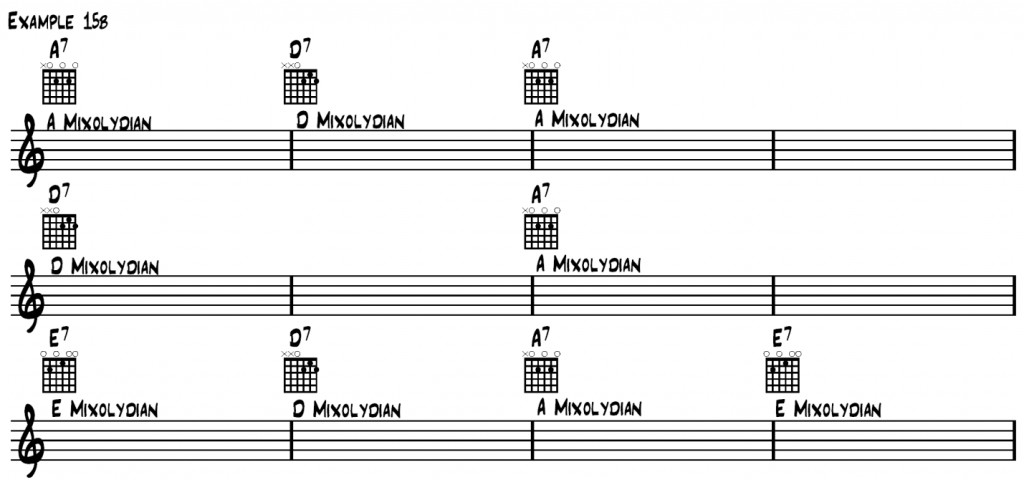Building upon your understanding of guitar modes, we now delve into the Mixolydian mode, a cornerstone of contemporary guitar music. Often hailed as a gateway to blues, rock, and funk styles, the Mixolydian scale offers a unique sonic flavor that distinguishes it from the familiar major scale. While sharing many notes with its major scale counterpart, a subtle yet impactful alteration gives Mixolydian its characteristic sound and versatility in both chord progressions and guitar solos. Let’s explore how the Mixolydian Scale On Guitar can enrich your musical vocabulary.
What is the Mixolydian Scale?
The Mixolydian mode is derived from the 5th degree of the major scale. Its formula, represented numerically, is 1 2 3 4 5 6 b7. This formula indicates that the Mixolydian scale is identical to the major scale, with one crucial difference: the 7th degree is flattened. This flattened 7th (b7) interval is what imparts the Mixolydian mode with its dominant character, making it perfectly suited for dominant 7th chords and blues-infused melodies.
In the key of A, the Mixolydian scale would be: A, B, C#, D, E, F#, G, A. Notice the G natural, which is the flattened 7th of A. Visually, on the guitar fretboard, the A Mixolydian scale can be represented as follows:
 Mixolydian mode guitar diagram
Mixolydian mode guitar diagram
Understanding this visual representation is key to applying the mixolydian scale on guitar across the fretboard. The diagram emphasizes the relationship to the Dominant 7 chord, highlighting its harmonic foundation.
Mixolydian Harmony and Chord Progressions
Harmonizing the Mixolydian scale creates a distinct set of chords. Here’s a breakdown of the chord types generated within the Mixolydian mode:
| Degree | Triad Chord Type | Seventh Chord Type | Example in A Mixolydian |
|---|---|---|---|
| I | Major | 7 (Dominant 7) | A7 |
| ii | Minor | Minor 7 | Bm7 |
| iii | Minor b5 | Minor 7b5 | C#m7b5 |
| IV | Major | Major 7 | Dmaj7 |
| v | Minor | Minor 7 | Em7 |
| vi | Minor | Minor 7 | F#m7 |
| bVII | Major | Major 7 | Gmaj7 |
A defining characteristic of Mixolydian harmony is the tonic chord (I) forming a Dominant 7th chord. In traditional music theory, dominant chords often imply resolution, but in blues, rock, and funk, the dominant 7th chord, and therefore the Mixolydian mode, can stand alone, creating a sense of tension or groove without immediate resolution. This is a key element in the typical Mixolydian sound.
Mixolydian chord progressions are often identified by the presence of the bVII major chord. The bVII chord adds a distinctive flavor, creating progressions that are neither strictly major nor minor, but possess a unique modal quality. A common Mixolydian progression is illustrated below:
 Mixolydian mode chord progression
Mixolydian mode chord progression
Mixolydian in Musical Styles
The Mixolydian mode is prevalent in various genres:
- Blues: The dominant 7th sound of Mixolydian is foundational to blues music. Many blues riffs and solos utilize the Mixolydian scale over dominant chords.
- Rock: Classic rock anthems frequently employ Mixolydian for both rhythm guitar parts and lead guitar solos. Its slightly edgy yet major tonality fits perfectly within the rock idiom.
- Funk: The rhythmic and groove-oriented nature of funk music aligns well with the Mixolydian mode. Its characteristic sound adds a distinctive flavor to funk chord progressions and improvisations.
Examples of songs that showcase the Mixolydian mode include:
- “Sweet Child o’ Mine” – Guns N’ Roses
- “Sweet Home Alabama” – Lynyrd Skynyrd
- “Ramblin’ Man” – The Allman Brothers Band
- “Summer Song” – Joe Satriani
- “Freeway Jam” – Jeff Beck
Conclusion
The mixolydian scale on guitar is an essential tool for any guitarist seeking to explore blues, rock, funk, and beyond. Its unique blend of major and dominant characteristics provides a rich harmonic and melodic palette. By understanding its formula, harmony, and applications, you can unlock new creative possibilities and enhance your guitar playing. Continue your exploration by examining Mixolydian licks, intervals, and triads to further enrich your understanding and application of this versatile mode.
